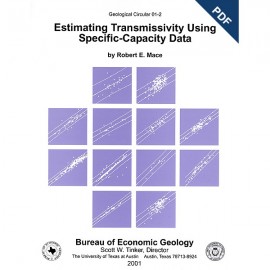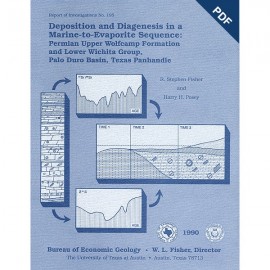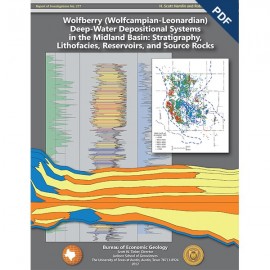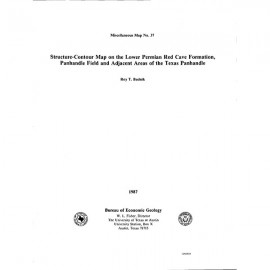Reports of Investigations
-
Books & Reports
- Reports of Investigations
- Guidebooks
- Udden Series
- Geological Circulars
- Down To Earth
- Atlases of Major Oil and Gas Reservoirs
- Texas Memorial Museum Publications
- Environmental Geologic Atlas of the Texas Coastal Zone
- Mineral Resource Circulars
- Other Reports
- Seminars and Workshops
- Handbooks
- Submerged Lands of Texas
- Symposia
- Annual Reports
- Open File Reports
-
Maps & Cross Sections
- Thematic Maps
- Miscellaneous Maps, Charts & Sections
- Geologic Atlas of Texas
- STATEMAP Project Maps
- Geologic Quadrangle Maps
- Cross Sections
- Highway Geology Map
- Energy and Mineral Resource Maps
- Shoreline Change and Other Posters
- Wilcox Group, East Texas, Geological / Hydrological Folios
- Bouguer Gravity Atlas of Texas
- River Basin Regional Studies
- Featured Maps
- Posters
- Teachers & the Public
-
Geological Society Publications
- Gulf Coast Association of Geological Societies
- Alabama Geological Society
- Austin Geological Society
- Corpus Christi Geological Society
- Houston Geological Society
- Lafayette Geological Society
- Mississippi Geological Society
- New Orleans Geological Society
- South Texas Geological Society
- GCS SEPM Publications
- Historic BEG & UT Series
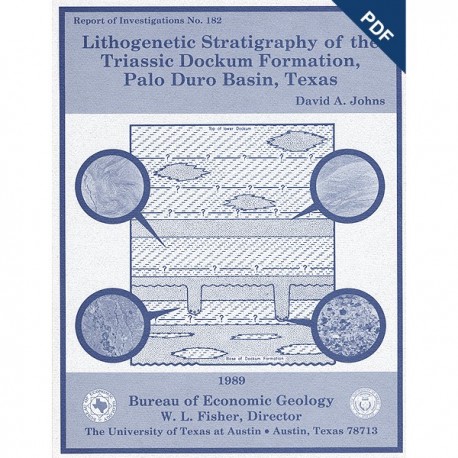
Lithogenetic Stratigraphy of the Triassic Dockum Formation, Palo Duro Basin, Texas. Digital Download
RI0182D
For a print version: RI0182.
RI0182D. Lithogenetic Stratigraphy of the Triassic Dockum Formation, Palo Duro Basin, Texas, by D. A. Johns. 71 p., 41 figs., 2 tables, 3 appendices, 1989. doi.org/10.23867/RI0182D. Downloadable PDF.
To purchase this publication in book format, please order RI0182.
ABSTRACT
Four clastic depositional sequences compose the lower part of the Triassic Dockum Formation in the Palo Duro Basin. Each sequence consists of a basal interbedded mudstone and interbedded siltstone succession overlain by an upper succession of sandstone containing minor conglomerate, siltstone, and mudstone beds. Regional cross sections indicate that the lower parts of sequences typically thicken basinward, whereas the upper sandy partsnbecome more discontinuous basinward and upsection. Lithofacies cross sections show that thick sandstones are more common in sequences I and II and in the eastern part of the basin, whereas interbedded sandstones and mudstones are more prevalent basinward and upsection. Core analysis indicates that the lower parts of each sequence consist of lacustrine and prodelta mudstones and siltstones. Delta-front and channel-fill sandstones dominate the upper parts of each sequence. Swamp and eolian lithofacies are rare. Paleosol horizons are commonly preserved in lacustrine and floodplain sediments.
Depositional sequences in the lower Dockum represent cycles of lacustrine transgression followed by clastic progradation, sometimes accompanied by a drop in base level. Sequence I was deposited by alluvial fans and fan deltas during a relatively dry climate before an extensive lake had formed, and therefore basal mudstone facies are absent. Sandstones in sequences II, III, and IV were deposited by bed- and mixed-load streams in fluvial and deltaic systems. Sequence II contains a large valley-fill system (IIb) that represents a major lake-level fall: less severe falls are recorded by paleosols in other sequences developed in lacustrine and prodelta mudstones and siltstones. Sequences IIIand IV record deposition in an expanding lake where sedimentation was dominated by lacustrine and deltaic systems: associated fluvial systems have generally been removed by erosion in updip areas. Deposition of the upper part of the Dockum Formation was probably similar to that of sequences III and IV.
Comparisons of isopach and percent-sandstone maps of the upper and lower parts of the Dockum Formation and of net-sandstone maps of the lower part of the Dockum with basement-structure maps reveal a coincidence between basement lows and highs and isopach and sandstone thicks and thins, respectively. Well-defined basement structures, for instance the Castro Trough system and the Littlefield positive structure, clearly influenced thickness and sandstone distribution patterns throughout most of the Late Triassic Epoch, probably by slight topographic expression. Other recurring isopach and sandstone thicks and thins may help define basement structures in lesser known areas.
The Dockum basin and the sediments in it resemble equivalent deposits in New Mexico and Arizona that were deposited in large structural depressions. Dockum rocks differ from equivalent deposits in rift basins in Mexico and along the Gulf and Atlantic coasts that are much thicker, more conglomeratic, and typically associated with igneous rocks.
Keywords: cores, depositional sequences, depositional systems, Dockum, lithofacies, paleogeography, Panhandle, subsurface, Texas, well logs
CONTENTS
Abstract
Introduction
Previous work
Stratigraphy
Methods
Discussion of Permian-Triassic boundary correlations
Regional Tectonic and Depositional Framework
Late Paleozoic Era
Triassic Period
Depositional framework
Depositional Sequences
Sequence I
Sequence II
Sequence III
Sequence IV
Sequence IVa
Upper Dockum sequences
Depositional Systems
Lacustrine system
Deltaic system
Fluvial-deltaic system
Eolian system
Lacustrine versus floodplain interpretations
Dip-oriented systems tracts
Type A tracts
Type B1 tract
Type B2 tract
Paleogeography
Initial Triassic paleogeography
Late Triassic Epoch
Sequence I
Sequence II
Sequence III
Sequence IV
Structure and Tectonics
Structural influence on deposition
Provenance
Postdepositional structural activity
Comparison with OtherTriassic Basins
Conclusions
Acknowledgments
References
Appendix A: Core description and interpretation of depositional sequences, Dockum Formation
Appendix B: Outcrop description and interpretation of sandstone units in depositional sequences, Dockum Formation
Appendix C: Wells included in cross sections in this study
Figures
1. Location map of study area and Late Triassic Dockum basin, West Texas
2. Generalized stratigraphic column. Upper Permian to Recent
3. Gamma-ray logs, lithology, and ash-bed locations, Dockum and Dewey Lake Formations, Palo Duro Basin
4. Structure-contour map, base of Dockum Formation
5. Isopach map of Dockum Formation
6. Percent-sandstone map of lower Dockum Formation
7. Percent-sandstone map of upper Dockum Formation
8. Definition of depositional sequences, lower Dockum Formation
9. Compressed lithologic cross section 4, Dockum Formation
10. Lithofacies fence diagram, Dockum Formation
11. Net-sandstone map of sequence I, lower Dockum Formation
12. Compressed lithologic cross section 5, Dockum Formation
13. Compressed lithologic cross section 6, Dockum Formation
14. Compressed lithologic cross section 1. Dockum Formation
15. Net-sandstone map of sequence II, lower Dockum Formation
16. Compressed lithologic cross section 2. Dockum Formation
17. Net-sandstone map of sequence 111, lower Dockum Formation
18. Net-sandstone map of sequence IV, lower Dockum Formation
19. Net-sandstone map of sequence IVa, lower Dockum Formation
20. Typical gamma-ray well log signatures, lower Dockum Formation
21. Core description of Mansfield No. 1 well, lower Dockum Formation
22. Core description of Grabbe No. I well, lower Dockum Formation
23. Core description of J. Friemel No. 1 well, lower Dockum Formation
24. Photographs of cores showing lacustrine lithofacies, lower Dockum Formation
25. Core description of Rex White No. 1 well, lower Dockum Formation
26. Photographs of cores showing examples of paleosols and other weathering effects, lower Dockum Formation
27. Photographs of cores showing prodelta lithofacies, lower Dockum Formation
28. Photographs of cores showing delta-front lithofacies, lower Dockum Formation
29. Measured section of lower Dockum Formation, San Jon Hill, Quay County, New Mexico
30. Measured section of lower Dockum Formation, Ragland 2, Quay County. New Mexico
31. Photographs of cores showing mixed-load fluvial channel-fill lithofacies, lower Dockum Formation
32. Photographs of cores showing bed-load fluvial channel-fill lithofacies, lower Dockum Formation
33. Paleogeography during deposition of episodes I through IV, lower Dockum Formation
34. Simplified basement-structure map, Palo Duro Basin
35. Isopach map of upper part of the Dockum Formation
36. Isopach map of lower part of the Dockum Formation
37. Simplified net-sandstone maps of lower Dockum sequences and superimposed basement structures, Palo Duro Basin
38. Basement profile and net Dockum sandstone distribution across Deaf Smith and Castro Counties, Texas
39. Basement profile and net Dockum sandstone distribution across Castro County, Texas
40. Basement profile and net Dockum sandstone distribution across Lamb County, Texas
41. Structure map, top of Dockum
Tables
1. Description and interpretation of facies in core, Dockum Formation
2. Comparison of some North American Triassic basins
Citation
Johns, D. A., 1989, Lithogenetic Stratigraphy of the Triassic Dockum Formation, Palo Duro Basin, Texas: The University of Texas at Austin, Bureau of Economic Geology, Report of Investigations No. 182, 71 p.

